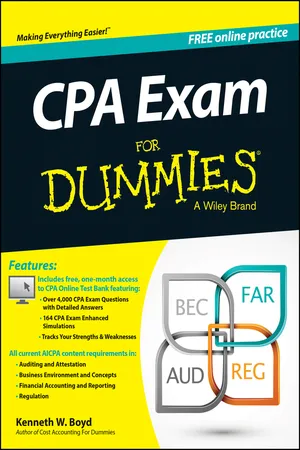
- English
- ePUB (mobile friendly)
- Available on iOS & Android
CPA Exam For Dummies with Online Practice
Kenneth W. Boyd
About This Book
Get started on the path to passing the CPA exam today
Passing the CPA exam can be the first step to a long and rewarding career. With CPA Exam For Dummies, you'll get a full overview of the exam, information on how to register, the requirements for taking and passing the tests, as well as a review of the four sections. This comprehensive introductory study guide provides you with a wealth of information, including all the current AICPA content requirements in auditing and attestation, business environment and concepts, financial accounting and reporting, and accounting regulation. From start to finish, the text is designed to prepare you for each portion of this rigorous exam.
Preparing for the CPA exam can be a daunting process. With the classic For Dummies approach, CPA Exam For Dummies offers an overview and steps on how to get started. Go at your own pace to master the various sections of the exam, and use the book as a reference on an ongoing basis as you prepare for the exam portions. Dive into the book to find:
- An overview of the CPA exam, featuring exam organization and information on scoring
- A content review, including practice questions and explanations of answers
- Online bonus practice exams to boost your knowledge and confidence
- An overview of the benefits of passing the CPA exam and becoming a certified public accountant
For those seeking to pass the CPA exam and launch their accounting careers, CPA Exam For Dummies is the go-to resource for getting started!
Frequently asked questions
Information
Table of contents
- Cover
- Title Page
- Table of Contents
- Introduction
- Part I: Getting Started with the CPA Exam
- Part II: Business Environment and Concepts
- Part III: Financial Accounting and Reporting
- Part IV: Auditing and Attestation
- Part V: Regulation
- Part VI: The Part of Tens
- Appendix: Linking to Wiley CPAexcel
- About the Author
- Cheat Sheet
- End User License Agreement